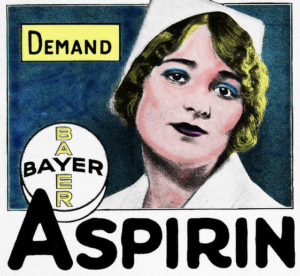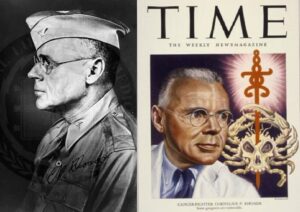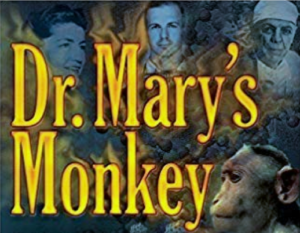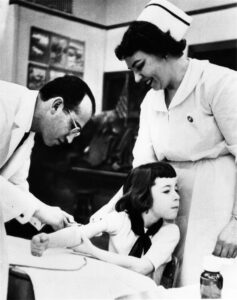 The turn of the 20th century promised to offer cures for every ailment with patented and colorfully packaged pills. Yet here we are. What happened? We were duped. More importantly, so were all of the well-meaning doctors, nurses, medical technicians, and scientists. There is a cancer within what we now know of as modern medicine – eating away at the very heart of its original design. Rather than saving and healing humanity, this cancer seeks to destroy us from within.
The turn of the 20th century promised to offer cures for every ailment with patented and colorfully packaged pills. Yet here we are. What happened? We were duped. More importantly, so were all of the well-meaning doctors, nurses, medical technicians, and scientists. There is a cancer within what we now know of as modern medicine – eating away at the very heart of its original design. Rather than saving and healing humanity, this cancer seeks to destroy us from within.
While many medical discoveries and innovations over the past century have undoubtedly saved lives, there is a small group of shadowy elites scattered throughout the world who have been quietly plotting to control the world population by infiltrating and shaping every aspect of modern medicine for the purposes of imposing their own agendas. No institution is immune. Medical schools, foundations, organizations, companies and government programs all have succumbed to this sickness. In order to surgically remove the cancer within modern medicine, we must first dissect and diagnose it. This report seeks to analyze the agendas, as well as the notable individuals, families, institutions, organizations, foundations and government programs involved in shaping the world of medicine since the turn of the 20th century.
Part 1: A Pill for Every Ill

John D. Rockefeller
In 1878, John D. Rockefeller controlled 90% of all oil refineries in the U.S. Then in 1897, a German chemist by the name of Felix Hoffman invented aspirin. With this discovery, a new frontier in medicine began with the use of petrochemicals in many medicines including aspirin, penicillin, and later for cancer-fighting drugs. The tycoon who had cornered the oil market in the U.S. sought to expand his empire with the exploitation of petrochemicals in this whole new world of medicine. At the time, homeopathic medicine was commonly practiced among doctors in the U.S. In order to dominate the emerging market of pharmaceuticals, Rockefeller would have to completely change the paradigm. This was no small feat.
First, the Rockefeller Institute for Medical Research was established by close friend and advisor, Frederick Taylor Gates, in 1901. Gates was inspired and influenced by the “Principles and Practice of Medicine” written by renowned physician and eugenicist, Sir William Osler, who attended the First International Eugenics Congress in 1912. Among the University’s alumni, notable figures such as Cornelius P. Rhoads (one of the early pioneers of chemotherapy) emerged, and 36 Nobel Prize laureates have been associated with the school. Their board of trustees has included names like Jeffrey Epstein, Maurice Greenberg, and Nancy Kissinger.
Next, Rockefeller set up the Rockefeller Foundation, which was originally conceived in 1904, and later established in 1913 by founders J.D. Rockefeller, his son, and his advisor Frederick Taylor Gates. In 1910, J.D. Rockefeller and a handful of others joined in a project to embark on this new frontier of the medical industry. They selected Abraham Flexner, backed by the Carnegie Foundation, to travel the country gathering evidence for a report on the state of medical colleges and hospitals.
The result of this venture was known as the Flexner Report, which was nothing short of a launching point for the world of modern medicine which we know today. The Flexner report was a tool used by Rockefeller to justify the modernization, streamlining, homogenization, and consolidation of medical schools and hospitals. Many schools and hospitals closed their doors as a result. Homeopathic medicine was demonized and mocked, while some doctors were even jailed.
The dawn of a new era began – the age of a ‘pill for every ill’. With new standards set in place by Rockefeller through the General Education Board in 1902, and the Flexner Report of 1910, the remaining medical schools and hospitals were incentivized to teach and research in specific areas in order to receive a stake of more than $100 million in Rockefeller Foundation grants. Research was driven in the area of finding synthetic alternatives to the organic plant-based treatments for illness, which homeopathic doctors had used in years past. Rockefeller found the synthetic drug alternative to be of benefit, as the newly discovered drugs could be patented, packaged and sold by any of the 68 subsidiaries within the Rockefeller drug empire.

Rockefeller: A Pill For Every Ill Agenda
In the mid 1920s, pharmaceutical companies were merely a peripheral branch of the chemical and cosmetics industries, but by 1928, the booming business climbed to the 16th most profitable industry in the U.S. After the discovery of penicillin in 1938, which led to government contracts with various drug companies to manufacture the drug in order to help the war effort, drug companies emerged post World War II with new capital to invest in the research and development of yet more drugs. The pharmaceutical industry exploded. By 1945, just one of Rockefeller’s subsidiaries, Squibb, reported profits of 576%, and the Rockefeller drug empire as a whole reported profits of 54% by 1961.
Over time, the smaller drug companies merged with larger ones, and from the second half of the 20th century to present day, increased consolidation of drug companies has led to the emergence of what we know of as big pharma. With billions in profits, the big pharma lobby has influenced lawmakers and policy alike to ensure its stronghold in the medical industry. Drug advertisements over the past 20 years have tripled to at least $6 billion per year as big pharma has found that they work.
Researchers are sounding the alarm that Americans are incredibly over-medicated, with as much as 55% of all Americans taking prescription drugs regularly – 4 on average, and an estimated $200 billion per year spent in the U.S. on unnecessary and improper use of medication (including the drugs themselves and related medical complication costs as a result). The overuse of pharmaceuticals has reached epidemic proportions, with the prescriptions of multiple medications to individual patients increasing by 200% over the past two decades. It is safe to say that Rockefeller’s vision of a ‘pill for every ill’ in America has been realized.
Part 2: A Cancer Within the Field of Cancer Treatment
Not only did Rockefeller play a pivotal role in the emergence of modern medicine and big pharma, as well as the near elimination of homeopathic medicine, but his investments led the frontier on cancer research as well. Rockefeller was allegedly instrumental in financially supporting the American Society for the Control of Cancer (the predecessor of the American Cancer Society) founded in 1913 by a small group of doctors and laypeople. Among the laymen listed as founding members of the society were Thomas M. Debevoise, the longtime attorney of J.D. Rockefeller and John Edward Parsons, the first president of Memorial Sloan Kettering Cancer Center, which was built on land donated by Rockefeller. A group of wealthy women were also on the ground floor of this cancer society, including Mrs. Frederick W. Vanderbilt, wife to the grandson of Cornelius Vanderbilt – the founder of Vanderbilt University and Mrs. Robert W. de Forest, wife of the Vice President of the American Red Cross – which received the Rockefeller Foundation’s very first grant.

Cornelius P. Rhoads
By the 1930s, the Rockefeller foundation backed the research of cancer treatments by Dr. Simon Flexner who was a trustee of the Rockefeller Foundation, the first director of the Rockefeller Institute for Medical Research, and brother of Abraham Flexner, as well as a colleague of Simon’s who worked in his lab at the Rockefeller Institute, named Cornelius P. Rhoads. Dr. Rhoads was commissioned by the Rockefeller Foundation to research blood-borne illnesses in Puerto Rico in 1932. While on the island, Rhoads wrote a letter to a colleague, bragging with delight over the murder of several patients, stating “They [Puerto Ricans] are beyond doubt the dirtiest, laziest, most degenerate and thievish race of men ever inhabiting this sphere. It makes you sick to inhabit the same island with them. They are even lower than Italians. What the island needs is not public health work but a tidal wave or something to totally exterminate the population. It might then be livable. I have done my best to further the process of extermination by killing 8 of them and transplanting cancer into several more. The latter has not resulted in any fatalities so far… The matter of consideration for the patients’ welfare plays no role here – in fact all physicians take delight in the abuse and torture of the unfortunate subjects.”
The letter was discovered by a colleague and made public, which resulted in Rhoads fleeing the island. Despite the public outcry, Rhoads went on to oversee the US Army Biological Weapons Division from which he allegedly conducted radiation experiments on thousands of American citizens. The research of mustard gas actually led to the implementation of the toxic potion in chemotherapy at Sloan Kettering Institute, where Rhoads was the director. Despite his unethical human experimentation, Rhoads was immortalized on the cover of Time Magazine, as well as the Cornelius P. Rhoads Memorial Award much to the shock of Puerto Ricans, who described the doctor as a genocidal mad scientist with full backing from the Rockefeller Foundation.
In 1929, a Harvard graduate who went on to become the President of the University of Michigan, C.C. Little, became managing director of the American Society for the Control of Cancer which later became the American Cancer Society. Known for his outspoken stance on eugenics, birth control, and euthanasia, C.C. Little also helped found the American Birth Control league with Margaret Sanger and Mary Lasker in 1921 and served as president of the American Eugenics Society. Little’s Jackson Laboratory supplied inbred lab rats for scientific research to a variety of laboratories and received the National Cancer Institute’s first grant. History may remember C.C. Little as yet another eugenicist who was instrumental for the early formations of cancer research and Planned Parenthood, but his most memorable contribution to science and modern medicine occurred while he served as Scientific Director of the Scientific Advisory Board of the Tobacco Industry Research Committee, when he stated, “there is no demonstrated causal relationship between smoking or any disease.”
 In 1939, Dr. Alton Oschner co-authored a paper which suggested a connection between cigarette smoking and lung cancer. The research received wide attention and Oschner joined the board for the American Cancer Society, where he later became president. Following his research into the link between smoking and cancer, the previous head of surgery at Tulane Medical School, Oschner, established the Oschner Clinic in 1942. He then recruited Dr. Mary Sherman to become partner in the New Orleans based clinic. She was also offered an Associate Professor position at Tulane Medical School. In a claim made in the 2007 expose entitled “Dr. Mary’s Monkey,” Dr. Alton Oschner and Dr. Mary Sherman “were implicated in a secret project to create a cancer-causing vaccine to assassinate Fidel Castro in the early 1960s.” As supporting evidence of this, another personal account written by Judyth Baker, claims that she was recruited to work on the clandestine project in April of 1963, when she met and became lovers with Lee Harvey Oswald. Baker’s story, Lee and Me, reveals that she was asked to participate in research regarding a weaponized form of cancer that was caused by the injection of a polio vaccine contaminated with the SV-40 virus. Based on a declassified FBI file, we now know that Alton Oschner had extensive ties to the intelligence community. According to Baker, David Ferrie, a suspect implicated in the JFK assassination conspiracy, worked in coordination with Oschner and Sherman while operating a second lab on Louisiana Avenue Parkway. Following the assassination of JFK, the Warren Commission arrived in New Orleans to investigate those suspected to be involved in the conspiracy. On the day of the Warren Commission’s arrival in New Orleans, July 21, 1964, Dr. Mary Sherman was found brutally stabbed to death and badly burned in her home. Two days after the assassination of JFK, Jack Ruby gunned down Lee Harvey Oswald during his transfer to county jail. Ruby was found guilty of murder and received a death penalty sentence, which was overturned upon an appeal in October of 1966. Before a second trial could begin, Ruby died from a pulmonary embolism shortly after a diagnosis of a highly aggressive widely metastatic cancer that had spread rapidly to his liver, lungs, and brain in the same facility where Oswald and JFK were pronounced dead, Parkland Hospital in Dallas, Texas.
In 1939, Dr. Alton Oschner co-authored a paper which suggested a connection between cigarette smoking and lung cancer. The research received wide attention and Oschner joined the board for the American Cancer Society, where he later became president. Following his research into the link between smoking and cancer, the previous head of surgery at Tulane Medical School, Oschner, established the Oschner Clinic in 1942. He then recruited Dr. Mary Sherman to become partner in the New Orleans based clinic. She was also offered an Associate Professor position at Tulane Medical School. In a claim made in the 2007 expose entitled “Dr. Mary’s Monkey,” Dr. Alton Oschner and Dr. Mary Sherman “were implicated in a secret project to create a cancer-causing vaccine to assassinate Fidel Castro in the early 1960s.” As supporting evidence of this, another personal account written by Judyth Baker, claims that she was recruited to work on the clandestine project in April of 1963, when she met and became lovers with Lee Harvey Oswald. Baker’s story, Lee and Me, reveals that she was asked to participate in research regarding a weaponized form of cancer that was caused by the injection of a polio vaccine contaminated with the SV-40 virus. Based on a declassified FBI file, we now know that Alton Oschner had extensive ties to the intelligence community. According to Baker, David Ferrie, a suspect implicated in the JFK assassination conspiracy, worked in coordination with Oschner and Sherman while operating a second lab on Louisiana Avenue Parkway. Following the assassination of JFK, the Warren Commission arrived in New Orleans to investigate those suspected to be involved in the conspiracy. On the day of the Warren Commission’s arrival in New Orleans, July 21, 1964, Dr. Mary Sherman was found brutally stabbed to death and badly burned in her home. Two days after the assassination of JFK, Jack Ruby gunned down Lee Harvey Oswald during his transfer to county jail. Ruby was found guilty of murder and received a death penalty sentence, which was overturned upon an appeal in October of 1966. Before a second trial could begin, Ruby died from a pulmonary embolism shortly after a diagnosis of a highly aggressive widely metastatic cancer that had spread rapidly to his liver, lungs, and brain in the same facility where Oswald and JFK were pronounced dead, Parkland Hospital in Dallas, Texas.

Dr. Jonas Salk
Following a lengthy career in the OSS, which led to the establishment of the CIA in 1947, Wild Bill Donovan was the Director of the NYC Cancer Committee of the American Cancer Society in 1952, a Board Chairman of the ACS in 1950 to 1952, and an Executive Committee Chairman of the American Cancer Society in 1953. A friend of Donovan’s, Mary Lasker, wife of the prominent ‘father of modern advertising,’ Albert Lasker, was an Honorary Chairman on the Board of Directors for the American Cancer Society, who played a key role in fundraising efforts for the research program and lobbied for the expansion of the National Institutes of Healthcare, increasing the budget 150 fold. She was later instrumental in the passage of the National Cancer Act of 1971, which granted government funds toward the National Cancer Institute and the War on Cancer. Both Albert and Mary Lasker were also prominent early figures in the origins of Planned Parenthood. The Albert and Mary Lasker Foundation fueled biomedical research with their deep pockets and one of the most prestigious awards in medical research, the Lasker Award.
Nearly 90 Lasker Award winners have received Nobel Prizes. Among the Lasker Award Laureates were Dr. Albert B. Sabin and Dr. Jonas Salk for their innovations as two of the earliest developers of a polio vaccine. Until 1963, both the Sabin and Salk vaccinations contained the simian virus 40 (SV40), exposing millions to the virus which may cause cancer, as mounting evidence shows. “The [SV-40] virus came from monkey kidney cell cultures used to make polio vaccines at that time,” according to the CDC. Furthermore, the CDC states, “From 1955 to 1963, an estimated 10-30% of polio vaccines administered in the US were contaminated with simian virus 40 (SV40).” “Approximately 100 million children and adults in the United States between 1955 and 1963, and countless more throughout the world,” were inoculated with the contaminated SV-40 polio vaccination and “reports of the detection of SV40 DNA in a variety of cancers have raised serious concerns as to whether the inadvertent inoculation with SV40 has led to the development of cancer in humans,” according to a 2006 Journal of Clinical Oncology report. The U.S. House of Representatives held a hearing in 2003 on the tainted polio vaccines and their possible link to cancer. Mrs. Lasker also served as a trustee for both the Cancer Research Institute and a director of the National Committee for Mental Hygiene and remained president of the Albert and Mary Lasker Foundation as well as honorary president of the American Cancer Society until her death in 1994. “Her last public appearance was in October at the 1993 Albert Lasker Awards luncheon in New York City addressed by First Lady Hillary Rodham Clinton.”
Despite billions in philanthropic and government funding, the cancer war raged on, reaching a peak in diagnosis and mortality rates in the early 1990s and slowly dropping off in more recent years. However, cancer has steadily remained the #2 cause of death in America to this day. Concerned citizens question why the billions in cancer research have produced fewer results than expected over the decades and allege that funds filtered through the American Cancer Society were never intended to produce a “cure.” American Cancer Society remains one of the wealthiest nonprofit organizations in the world, having received $736 million in donations from the public in 2017. Such astronomical sums beg the question: What would happen to the American Cancer Society’s funding if a cure were ever discovered?
Like a cancer, the web of influence from shadowy elites has transformed the world of modern medicine we know of today – from our overconsumption of pharmaceuticals fueling the big pharma industry to our dependence on chemotherapy for a cancer treatment, with little hope in sight for a cure.
We highly encourage readers to watch this impactful 17 minute documentary on the story of Royal Rife and his medical research, which was heavily suppressed by the Rockefeller big pharma and surgical modern medicine industry.
Special thanks to pathologist and friend, Dr. B, for contributions to this report.
~ The Series ~
Parts 1 & 2: The Cancer Within Modern Medicine
Part 3: The Cancer Within Modern Medicine ~ The Obsession With Unnatural Selection
Part 4: The Cancer Within Modern Medicine: Manipulation of the Minds
Part 5 ~ The Cancer Within Modern Medicine: Transhumanism
Editor’s NOTE: Parts 1 & 2 are the only chapters which appear on another site – DrKelley.net – as they are the ONLY chapters, which actually deal with the physicality of the “disease” that we call ‘Cancer’. Chapters 3 through 5 deal with the ‘cancer’ of the control of the minds of ‘We – the People.’ It is called ‘Politics.’ ~ Editor
Written by The Sharp Edge for Corey’s Digs ~ October 30, 2018
